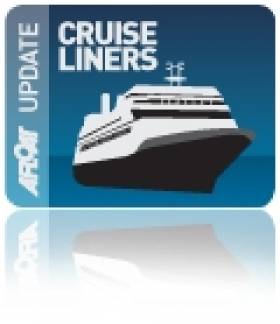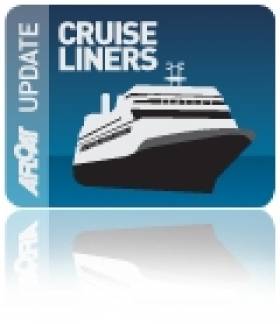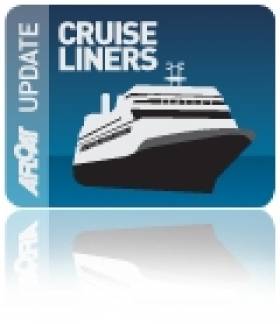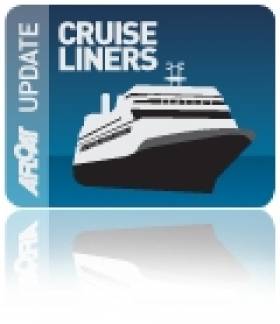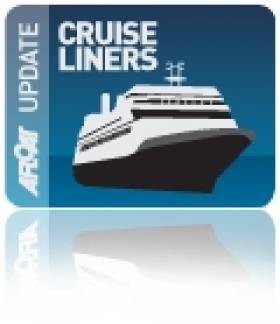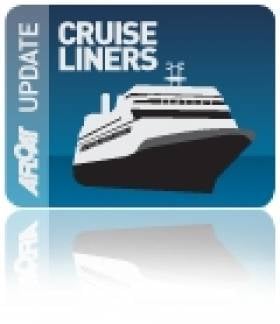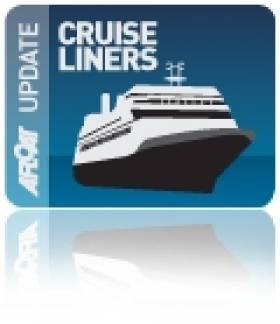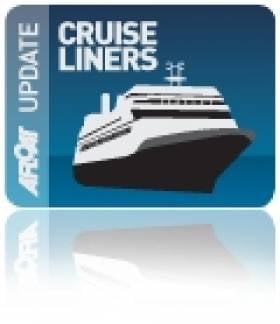Displaying items by tag: QM2
#LinerQueenMary2- Queen Mary 2 is currently underway and bound for Dublin Bay, having departed Greenock Ocean Terminal, where she launched the cruise season at the Clyde port. Tomorrow morning the world's only 'liner' will make her historic maiden anchorage call off Dun Laoghaire Harbour, writes Jehan Ashmore.
The 345m Cunard Line 'flagship' was the first of five cruise call scheduled in just six days to visit Greenock from where the 2,600 passenger capacity liner mostly with passengers from Germany, had embarked on a cruise starting in Hamburg.
The call of Queen Mary 2 to the Scottish port is apt in that her predecessor Queen Elizabeth otherwise affectionately known as the 'QE2' was launched downriver on Clydebank at the John Brown shipyard and entered service in 1969.
The famous liner served on the trans-Atlantic 'liner' route until replaced by the considerably larger Queen Mary 2 or also referred as 'QM2' ' in 2004. Only twice has the Queen Elizabeth 2 visited Dublin Bay, on both occasions anchoring off Dun Laoghaire Harbour.
As the expectations rise of the arrival of Queen Mary 2 on the horizon of Dublin Bay so too will the looming giant all of 151,400 tonnes. The French built liner was launched in 2003 from the Chantiers de l'Atlantique shipyard in St. Nazaire near Nantes.
At around 06.00hrs tomorrow, a pilot cutter from Dublin Port will meet Queen Mary 2 on the fringes off the bay from where the 14 passenger deck ship will edge ever closer to anchor around an hour later some 1.2 nautical miles north-east of the East Pier lighthouse, which should give an excellent vantage point.
From around 07.30 tender craft from the liner are expected to shuttle to and fro to the cruise-dock tender pontoon in the Coal Harbour, where a 'five-star' welcome will see passengers greeted by a piper and Irish dancers as they embark.
A 'mini cruise-festival' for both cruise and domestic visitors will include family entertainment, face painting, a complimentary vintage bus and live music and dancing and special offers throughout the town.
In addition special QM2 themed boat excursions will be circling the liner during the afternoon before the liner is scheduled to depart around 17.30hrs.
It is estimated the visit to local economy will be boosted by €400,000 and places Dun Laoghaire Harbour on the map as a port of destination for larger international cruise operators.
#LinerQueenMary2 -Final preparations are underway as Dún Laoghaire gears up for the first ever visit of the world's only ocean liner – the giant RMS Queen Mary 2.
The impressive Cunard Line 'flagship' all of 151,400 tonnes, is due to anchor offshore of Dun Laoghaire Harbour on Thursday morning, at around 07.00hrs.She has a 2,600 passnenger capacity and a crew of 1,200.
Her inaugural call is to bring a €400,000 boost to the local economy during her one-day visit!
In total €3m is to be generated from the 2013 cruise season with 14 arrivals bringing 30,000 passengers to Dún Laoghaire Harbour. In stark contrast to last year when the port handled just 300 passengers.
A five star welcome will see the QM2 passengers greeted by a piper and Irish dancers as they embark at the old Coal Harbour, where the cruise-dock pontoon was installed last year for use by such large deep-drafted vessels and their tender craft.
To get around the town, a shuttle bus will bring passengers to receive a warm welcome in the grounds of the Royal Marine Hotel, where guests will be greeted with mini-samples of Guinness, character actors from local tourism sites.
A bespoke 'tourism office' with volunteers will provide tourism information and handing out booklets of vouchers and offers for shops, restaurants and tourism outlets in the area.
In addition a Dún Laoghaire phone app has been specially developed for cruise passengers to maximise enjoyment and avail of special discounts and offers while touring the town.
The Dún Laoghaire Cruise Stakeholders' Group has also installed an advanced wireless facility in Dún Laoghaire so passengers can enjoy extensive free internet access throughout the town itself and extending as far as the cruise liner during their stay.
A 'mini cruise-festival' for both cruise and domestic visitors will include food and craft markets, family entertainment, boat trips circling Queen Mary 2 and there is to be live music aired throughout the town.
Don McManus, chairman of the Dún Laoghaire Business Association says excitement is rife among the Dún Laoghaire Business community: "The arrival of the Queen Mary 2 on Thursday marks the beginning of a new era for Dún Laoghaire. The business community has been hugely supportive in funding the cruise welcome and associated publicity. We have big plans to continue with the rapid development of the lucrative cruise market in the coming years. Last year saw the arrival of just two cruise ships carrying 300 crew and passengers.
Following the establishment of a Dún Laoghaire Cruise Stakeholder Group and an aggressive international marketing strategy, this year we will welcome fourteen cruise ships with over 30,000 passengers and crew!"
The initiative is supported by Dún Laoghaire Harbour Company, Dún Laoghaire Rathdown Co. Council and the Dún Laoghaire Business Association
#LinerQM2 – A once in a lifetime opportunity to see fantastic close-up views of the giant Queen Mary 2 (QM2) during the liner's historic inaugural call off Dun Laoghaire Harbour are available with a Dublin Bay Cruises excursion, writes Jehan Ashmore.
The Dun Laoghaire based operator is running two special cruises to circle the 2,620 passenger QM2, the world's only liner during her 'anchorage' call next Thursday (16 May). Cruises depart from the East Pier (15.30 and 17.00) and head into Dublin Bay where the 151,400 tonnes Cunard Line 'flagship' will tower above the excursion boat St. Bridget.
Queen Mary 2 was built at the famous shipyard of Chantiers de l'Atlantique, St. Nazaire, France and cost €659m (US$800 million). The liner entered service in 2004 and to give a sense of her sheer size, she is 1,132 feet long, 236 feet high, 135 feet on the beam and has a draft of 32 feet.
Among the facilities, there are 15 restaurants and bars, five swimming pools, a casino, ballroom, theatre, spa-club, the only planetarium at sea and a 3D cinema. The Bermuda flagged liner which has 14 decks has a crew of 1,200.
She was named after the original Queen Mary which remains moored as a static floating hotel in Long Beach, California. Uniquely the Queen Mary 2 continues the tradition of the trans-Atlantic 'liner' which reflect a bygone era of the classic voyage between Southampton and New York.
Her call follows her predecessor the 70,000 tonnes Queen Elizabeth 2 (QE2), which twice made anchorage calls offshore of Dun Laoghaire more than a decade ago.
Queen Mary 2 kicks off the 2013 cruise liner season in Dun Laoghaire, Dublin early on Thursday, May 16 and she'll be visible off the Kish lighthouse at the entrance to Dublin Bay from before 6am onher journey from Greenock in Scotland.
The 151,400 tonnes giant vessel will make her way to the southside of the bay before anchoring in Scotsman's Bay, Sandycove for the day, approximately 1.8 nautical miles to the north east of Dun Laoghaire's East Pier.
Her passengers are mostly German with the cruise originating in Hamburg, the recent venue for the world's biggest port festival.
The liner will be at anchor in the bay all day on Thursday, departing at 17.30 and heading for Holyhead, on the far side of the Irish Sea.
Click for more on Queen Mary 2 ship and her visit to Dun Laoghaire
#LinerQueenMary2- The eagerly awaited visit of the world's only 'liner', Cunard Line's flagship Queen Mary 2 is now just over a week away to making her first ever visit to Dublin Bay with an 'anchorage' call off Dun Laoghaire Harbour, writes Jehan Ashmore. The liner arrives next Thursday, May 16th.
The significance of the call of Queen Mary 2 or 'QM2' as she is affectionately known will no doubt generate a major draw for onlookers when she arrives on the Dublin Bay horizon from a northerly direction around 06.00hrs.
Vantage points lining the East Pier, Scotsman's Bay and beyond will be condusive to witness the sheer size of the 151,400 tonnes giant vessel as she looms towards Dun Laoghaire.
The French built liner which cost €659m (US$800 million) is currently on a trans-Atlantic voyage and is bound for her homeport of Southampton. The liner represents a link to the past of the bygone era in travelling the Atlantic in complete luxury while capturing the essence of the classic sailing voyage experience to and from New York.
Facilities are both elegant and grand and where her 2,600 passengers have no less than 14 spacious decks with all the luxury one would expect with such liner prestige and historical pedigree.
Among the amenities guests can enjoy the Canyon Ranch spa-club, the only planetarium at sea and a 3D cinema.
Queen Mary 2 will be the highlight for the Dun Laoghaire Harbour Company as the passenger liner also marks the opening of the 2013 cruise season, and where such a large vessel will provide a much needed boost to regional tourism.
The port can also look forward to a dramatic increase this season as a further dozen or so cruise calls are scheduled to bring 30,000 passengers and crew to the port, a stark contrast to last year's return to this business sector with just two calls.
Another first will be the use of the purpose built cruise liner dock pontoon, when the QM2's tenders are expected to berth at the facility in the Coal Harbour.
The QM2's predecessor of only half her size the 70,000 tonnes Queen Elizabeth II (QE2) had made two anchorage calls offshore of Dun Laoghaire Harbour as did some other well known large cruiseships more than a decade ago.
In regards to Queen Mary 2, this will be her third call to Irish waters and as with the first visit, she too made an anchorage call offshore of Dunmore East in 2005. On her second call to Cobh in 2011 this involved berthing alongside the quay.
#CruiseShips- A mini-luxury cruiseship Sea Explorer docked in Dun Laoghaire Harbour today, fortunately without passengers on board, as a very unseasonable Dublin Bay was battered by a heavy snow squall, writes Jehan Ashmore.
As the Sea Explorer approached Dun Laoghaire Harbour, the pilot cutter 'Liffey' which set out from Dublin Port came alongside to transfer a pilot aboard the 4,200 tonne vessel which was arriving on a passage from Cadiz.
Sea Explorer which has a passenger capacity for 116 passengers is to remain moored in the harbour albeit in a 'lay-up' mode in advance to taking up a European season with cruises starting in June from a temporary 'homeport'.
It is the norm for cruiseships to reposition between seasons and operating regions around the world, such as the Caribbean and Mediterranean and relocate to a designated homeport.
As previously reported on Afloat.ie, Dun Laoghaire Harbour is expected to receive up to 14 cruise calls this season, including the highlight call of Cunard Line's flagship liner 'QM2' on 16 May.
Also reported was yesterday's launch of the National Ports Policy where Minister for Transport, Leo Varadkar announced that Dun Laoghaire Harbour along with four other ports were classed as having 'regional significance'.
In the case of Dun Laoghaire Harbour, the development of the port is to be in line with local requirements focusing on tourism, cruise liners and marine leisure activity.
The ports are to be transferred to the control of local authorities in a move that will require legislation which may take up to 18 months to complete.
Meanwhile, Sea Explorer will be sharing the same quayside at the ferry terminal with the new Dublin Bay Cruises excursion vessel, St. Bridget.
On the adjacent berth is another vessel with a similar name to the cruiseship, that being the HSS Stena Explorer which operates the seasonal-only fast-craft ferry service to Holyhead.
Finally, the port has also been engaged in a return to cargsoships with the third batch of Guinness fermentation tanks, which were discharged from the Blue Tune on Monday. This final batch are bound for the St. James's Gate Brewery plant in Dublin.
#CRUISELINERS – The Quest (1992/1,180grt) an ice-strengthened expedition cruiseship, will have the distinction of being the first cruise caller to Dun Laoghaire Harbour in many years. The cruise call next week (24th April) will mark a new era in attracting the cruise sector as part of the harbour's masterplan launched last year, writes Jehan Ashmore.
The Quest will have a German clientele of around 50 passengers, though other larger capacity vessels are scheduled for the summer in this first phase of cruise callers. The cruise sector season is seen to be a significant economic boost to the local economy considering the reduced ferry side of the harbour business in recent years.
Passengers on the Noble Caledonia operated vessel are to take a 9-night 'Garden' Cruise with prices starting from £3,295. She is to set sail from Oban Scotland, then to Ireland, Wales, Cornwall, the Isles of Scilly and Channel Islands.
On her Dun Laoghaire call passengers will head for Powerscourt and nearby Mount Usher gardens in Co. Wicklow. On the second Irish port of call to Waterford as previously reported, they will visit the privately owned Mount Congreve Gardens on the banks of the River Suir.
Notably scheduled in for next year's season is the 'flagship' of the Cunard Line fleet, the 2,620 passenger liner Queen Mary 2, all of 151,400 gross tonnes. She is to make an anchorage call in May 2013, according to Captain Frank Allan, Dun Laoghaire Harbourmaster.
As part of the programme to attract and develop Dun Laoghaire as a cruise call port of call, a new tender docking facility was recently completed. The facility is designed to cater for large cruiseships using the harbour as it will cater for easier access by boats tendering passengers to vessels such as Queen Mary 2 during anchorage calls out in Dublin Bay.
The new tender facility will also benefit the public as the facility can be used for training purposes and for the operation of boat tours around Dublin Bay and trips out to Dalkey Island.
- Dun Laoghaire Harbour
- Cruise Liners
- Irish cruise calls
- Noble Caledonia
- MVQuest
- Cunard Line
- Queen Mary 2
- QM2
- Dun Laoghaire Harbour Company
- Dublin Bay
- Dublin Bay anchorage cruise calls
- Dalkey Island
- Powerscourt Gardens
- Mount Congreve Gardens Waterford
- River Suir
- Dun Laoghaire Harbour Masterplan
- Dublin Bay News
Cunard Line Flagship Queen Mary 2 Calls to Cobh
The current liner (QM2) can carry 2,620 passengers and a crew of over 1,200 on a vessel is the longest, tallest and widest of any passenger liner built. The luxury liner has private balconies for nearly 80 per cent of cabins and has an art collection worth £3.5m. To complement these works of art there is the first 'floating planetarium', the largest library at sea, boasting 8,000 hardbacks and also the largest ballroom to grace a ship on the oceans.
Queen Mary 2 was short-listed to be built in Belfast at the Harland & Wolff shipyard, but the contract went to Chantiers d'Atlantique, St. Nazaire on the west coast of France.
Her first visit to Irish waters occurred when she anchored off Dunmore East in 2005, the liner had arrived overnight on a passage from her homeport of Southampton and was on a nine-day cruise of British, Irish and Baltic state ports.
Today's Cobh visit of the 345m long Queen Mary 2 coincided with Ocean Countess, a former 'Cunarder', which is also in the port. The 163m vessel was built in 1976 and launched as their Cunard Countess. She weighs 17,593grt and has a 800 passenger capacity. Last year she joined Cruise & Maritime Voyages (CMV) fleet under charter from Majestic International Cruises Group.
Also at work in Cork Harbour was the excursion vessel Spirit of the Isles which apart from operating River Lee sight-seeing cruises between Cork city-centre and Cobh at the weekends, is running a charter cruise this afternoon to Spike Island. For information about sightseeing trips and chartering click HERE.
Queen’s Namesake to Retrace Royal Visit
The 90,901 gross registered tonnes cruise ship is to depart her Hampshire homeport, where she is to similarly follow the monarch in that she is scheduled to make a port of call to Dublin first on 9 September and make a call to Cork afterwards.
With a length of 295m / 965-feet the vessel will dock in the centre of the capital port before she sails overnight to make a morning arrival at Cobh, the dedicated cruise terminal for the Port of Cork. She is scheduled to stay at the Cork Harbour town formerly named Queenstown until a 17.00 hour departure.
Her visit coincides with Cork Harbour Open Day, where visitors can view the impressive vessel from the quayside, for more details visit www.corkharbour.ie
Incidentally her near-sister Queen Victoria also called to Dublin in May and the remaining vessel of the Cunard fleet, the 'flagship' liner Queen Mary 2 is also to dock in Cobh three days later after Queen Elisabeth's visit.
- Cobh
- Cork Harbour
- port of Cork
- Cruise Liners
- Cork Harbour Open Day
- Ports and Shipping
- Cobh Cruise Terminal
- Queen Elizabeth II
- Cork Harbour News
- Port of Cork Company
- Cunard Line
- queen victoria
- Port of Cork News
- Queen Elizabeth
- Queen Mary 2
- QM2
- Cruise Liner news
- TransAtlantic Liners
- Cruise ships
- Irish cruiseship calls
- Queen's visit to Ireland
- QV
- QE
- Cunarders
- Cobh Cunarders
- Cobh cruise calls
- Cunard liners
- Cunard cruiseships
- Royal visit to Ireland
- Cobh cruise liners list
Cork's Cruiseship's Call Schedule 2011
The inaugural call for this season was made last Monday by Cunard Line's Queen Victoria (90,049grt) and the four year-old vessel is to return for another visit on 5 May. Her slighty larger sister Queen Elizabeth (90,400grt) will make her maiden 'Irish' port of call on 10 September.
Last Autumn the 2,092 passenger cruiseship newbuild was 'floated-out' of the building dry-dock at Fincantieri's Monfalcone shipyard in Italy. At 294m long her hull is derived from the 'Vista' class series built for Carnival Corporation, owners of the Cunard Line.
Four days later the Cunard 'flagship' Queen Mary 2 (QM2) will also make an appearance. The 148,528grt French built vessel is the only designated cruise-liner in the world, the title was handed on from her predecessor, Queen Elizabeth II (QE2).
Throughout the career of the iconic liner, she made several calls to Cork (Ringaskiddy) while employed on the Atlantic 'liner' service between Southampton and New York.
On her farewell cruise QE2 made her first and only call to Cobh in 2008, the 70,327grt ship was meant to stay for a standard day-long visit but due to strong windy weather conditions in Cherbourg, she was prevented from docking and spent an un-scheduled overnight stay in the picturesque location.
The scheduling of all three 'Cunarders' to Cobh will be a first for the Port of Cork. Asides the Italian-built trio, there will be plenty more cruise callers lined up for the season, notably the Independence of the Seas, the largest cruiseship caller to an Irish port.
The Finnish built giant weighs 154,407 grt (some 6,000 tonnes larger than the liner QM2) and can carry 4,375 passengers.
Another large visitor will be the Azura at 115,055grt which can handle 3,100 passengers. She is the built to a design based from the 'Grand' class ships commissioned for Carnival Corporation's which also owns Princess Cruises.
The value of the cruiseship sector business to the island of Ireland this year is valued at €60m. The list below is a schedule of cruiseship calls to Cork Harbour (Cobh, Ringaskiddy and Cork city-centre quays).
Please note information is based in the order of ship's name first, passenger capacity (PAX), arrival date (time), location of berth and lastly departure date (time). For the most up-to-date information please refer to the Port of Cork Company website cruise call list.
ATHENA 580 Apr 27th at 08:00 Cobh Cruise Terminal
CELEBRITY ECLIPSE 3129 Apr 30th at 14:00 Cobh Cruise Terminal
May 1st at 16:00
INDEPENDENCE OF THE SEAS 4375 May 1st at 17:00 Cobh Cruise Terminal
May 2nd at 18:00
CELEBRITY ECLIPSE 3129 May 4th at 14:00 Cobh Cruise Terminal
DISCOVERY 689 May 4th at 07:00 Ringaskiddy DWB May 4th at 22:00
QUEEN VICTORIA 2000 May 5th at 20:02 Cobh Cruise Terminal
May 25th at 18:00
EMERALD PRINCESS 3592 May 6th at 08:00 Cobh Cruise Terminal
May 6th at 19:00
LE BOREAL 260 May 9th at 07:00 Cobh Cruise Terminal May 9th at 17:00
GRAND PRINCESS 3300 May 15th at 06:00 Cobh Cruise Terminal
May 15th at 17:00
COSTA DELIZIOSA 2826 May 17th at 07:00 Cobh Cruise Terminal
May 17th at 19:00
CROWN PRINCESS 3114 May 24th at 07:00 Cobh Cruise Terminal
May 24th at 17:00
ROTTERDAM 1668 May 26th at 07:00 Cobh Cruise Terminal
May 26th at 17:00
SILVER WHISPER 1668 May 28th at 09:00 Cobh Cruise Terminal
May 28th at 23:00
LE DIAMANT 200 Jun 22nd at 06:00 Cobh Cruise Terminal
Jun 22nd at 19:00
ASTOR 656 Jun 27th at 06:00 Ringaskiddy DWB
SILVER CLOUD 296 Jun 27th at 07:00 Cobh Cruise Terminal
Jun 27th at 19:00
MINERVA 352 Jul 1st at 07:00 Cobh Cruise Terminal
LE DIAMANT 200 Jul 7th at 06:00 North Custom House Quay
Jul 7th at 23:30
AURORA 1950 Jul 7th at 11:30 Cobh Cruise Terminal
Jul 7th at 23:00
ATHENA 580 Jul 15th at 08:00 Cobh Cruise Terminal
Jul 15th at 17:00
SILVER CLOUD 296 Jul 18th at 07:00 Cobh Cruise Terminal
Jul 18th at 19:00
SPIRIT OF ADVENTURE 470 Jul 19th at 06:00 North Custom House Quay
Jul 19th at 18:00
ROTTERDAM 1668 Jul 19th at 07:00 Cobh Cruise Terminal
Jul 19th at 17:00
AZURA 3100 Jul 19th at 08:00 Ringaskiddy DWB
Jul 19th at 18:00
DAWN PRINCESS 2342 Jul 24th at 06:00 Cobh Cruise Terminal
Jul 24th at 17:00
CROWN PRINCESS 3114 Jul 26th at 07:00 Cobh Cruise Terminal
Jul 26th at 17:00
MARINA- Jul 27th at 07:00 Cobh Cruise Terminal
Jul 27th at 18:00
AIDABLU 2580 Aug 11th at 07:00 Cobh Cruise Terminal
Aug 11th at 18:00
MAASDAM 1613 Aug 13th at 06:00 Cobh Cruise Terminal
Aug 13th at 15:00
SEVEN SEAS VOYAGER 730 Aug 17th at 07:00 Cobh Cruise Terminal
Aug 17th at 15:00
CROWN PRINCESS 3114 Aug 18th at 07:00 Cobh Cruise Terminal
Aug 18th at 17:00
LE DIAMANT 200 Aug 19th at 06:00 Cobh Cruise Terminal
Aug 19th at 23:30
CLIPPER ODYSSEY 128 Aug 19th at 07:00 Cobh Cruise Terminal
Aug 19th at 21:00
ATHENA 580 Aug 22nd at 07:30 Cobh Cruise Terminal
Aug 22nd at 17:00
AIDABLU 2580 Aug 25th at 07:00 Cobh Cruise Terminal
Aug 25th at 18:00
LE DIAMANT 200 Aug 26th at 06:00 Cobh Cruise Terminal
Aug 26th at 23:00
ARCADIA 2388 Aug 29th at 07:00 Cobh Cruise Terminal
Aug 29th at 17:00
AZAMARA JOURNEY 702 Aug 31st at 08:00 Cobh Cruise Terminal
COSTA DELIZIOSA 2826 Sep 1st at 07:00 Cobh Cruise Terminal
Sep 1st at 18:00
LE DIAMANT 200 Sep 3rd at 07:00 North Custom House Quay
Sep 3rd at 17:00
PRINSENDAM 843 Sep 3rd at 09:00 Cobh Cruise Terminal
Sep 3rd at 18:00
DISCOVERY 689 Sep 4th at 08:00 Cobh Cruise Terminal
Sep 4th at 18:00
SILVER CLOUD 296 Sep 5th at 07:00 Cobh Cruise Terminal
Sep 5th at 18:00
JEWEL OF THE SEAS 2500 Sep 6th at 08:00 Cobh Cruise Terminal
Sep 6th at 16:00
SILVER WHISPER 388 Sep 10th at 06:00 Cobh Cruise Terminal
Sep 10th at 18:00
QUEEN ELIZABETH 2092 Sep 10th at 08:00 Ringaskiddy DWB
Sep 10th at 17:00
OCEAN COUNTESS 884 Sep 14th at 06:30 Ringaskiddy DWB
Sep 14th at 16:30
QUEEN MARY 2 2592 Sep 14th at 08:00 Cobh Cruise Terminal
Sep 14th at 17:00
OCEAN COUNTESS 884 Sep 16th at 07:30 Cobh Cruise Terminal
FRAM 500 Sep 28th at 07:00 Cobh Cruise Terminal
Sep 28th at 18:00
SAGA RUBY 668 Dec 15th at 07:00 Cobh Cruise Terminal
Dec 15th at 23:00
- Cruiseships
- Cruise Liners
- Cork Harbour
- Cork Harbour News
- Port of Cork Company
- Port of Cork News
- Cobh
- Cobh Cruise Terminal
- Cunard Line
- Carnival Corporation
- Princess Cruises
- queen victoria
- Queen Elizabeth
- Queen Elizabeth II
- QE2
- Queen Mary 2
- QM2
- Independence of the Seas
- Royal Carribean Cruise Line
- RCCL
- Fincantieri
- Grandclass
- Vistaclass
- Ports and Shipping News


























